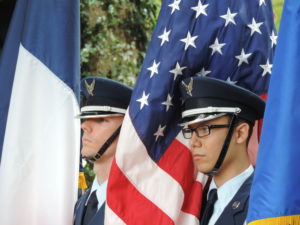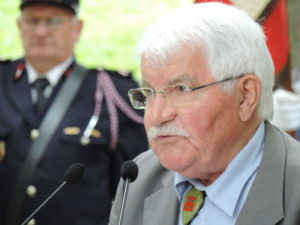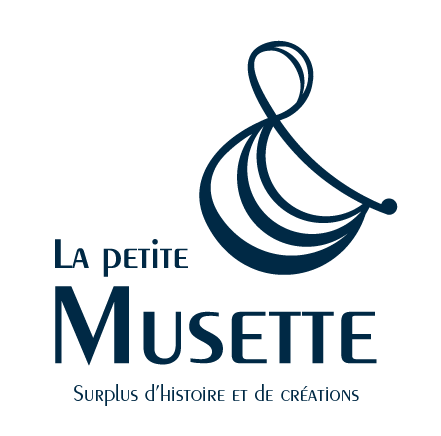by Bertrand Froger | 16 Mar 2018 | Collections, Historical events, Life of soldiers
Dog tagS,
various markings
We are often asked how the dog tags were struck at the time, then small turtoriel on the different strikes existing in time on the plate M1940. Attention, a soldier can be remap his own plates during his war so the typing pattern does not correspond to the date of engagement. To hit your own dog tags
https://boutique.lapetitemusette.com/fr/accueil/16-dog-tag-personnalise.html
December 1940 – November 1941
1st line: First name, first letter of 2nd name, last name
2nd line: Number, blood type
3rd line: First name and last name of the person to contact
4th line: Address of the contact person
5th line: City and state of the contact person

November 1941 – July 1943
(addition of tetanus and religion)
1st line: First name, first letter of 2nd name, last name
2nd line: number, tetanus vaccination, tetanus booster, blood group
3rd line: First name and last name of the person to contact
4th line: Address of the contact person
5th line: City and state of the contact person, religion

July 1943 – March1944
(withdrawal of the person to contact for fear of reprisals)
1st line: First name, first letter of 2nd name, last name
2nd line: number, tetanus vaccination, tetanus booster, blood group
3rd line:
4th line:
5th line: Religion

March 1944 – April1946
(Name and surname inversion)
1st line: Surname, first name
2nd line: number, tetanus vaccination, tetanus booster, blood group
3rd line:
4th line:
5th line: Religion

by Bertrand Froger | 12 Mar 2018 | Anecdotes, Historical events
Origins
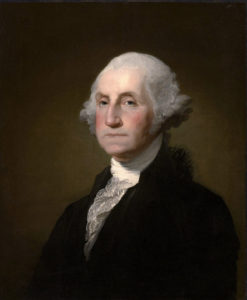
To understand this vulgar term that could literally be translated as “Labels for Dog”, we must go back to the 18th century. The United States of America faces a real problem of stray dogs in the cities and the countryside, causing a lot of damage but also many attacks on the population. Thus, George Washington decides to launch a vast operation of canine cleaning on the territory and proclaims a law obliging any canine owner to make carry to his animal a collar with the name and the coordinates of its owner.
Civil wars
Throughout the history of the United States, soldiers of more or less important and more or less official armies die and are buried on the battlefield. Before being soldiers, these characters are men, fathers, husbands, brothers. However, once the tragedy occurred during an attack, there is nothing to identify them, and all these soldiers are buried in mass graves, anonymously, in the middle of a field or a wood hundreds of kilometers away. from their house. During the Civil War (1861-1865), men only want to remain anonymous and improvise different systems to recognize their body. Some cling a paper tag with their name on the bag or
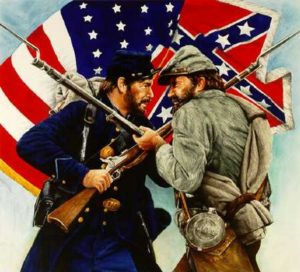
on the jacket with a pin; while others strike their initials on a coin they come wearing as a pendant. Some traders behind the lines are already at this time the seam to make custom pendants more or less luxurious for soldiers going to war. We are witnessing incredible initiatives. For example, General George Meade who, just before the Battle of Mine Run in Northern Virginia (1863), orders all his men to write their names on a white label and pin him on them before going into battle .
Dog Tag was born
After the carnage of this war, the Americans continue the protest movement and want to gather on the grave of their dead, Congress and the army are forced to seek a solution. Thus, in 1906, inspired by medallions previously marketed, a “plate of identity” project was born. It is sponsored by Chaplain Charles Pierce in charge of the Quartermaster Office of Identification. Adopted in 1913 on the eve of the First World War, American soldiers are required to wear a small aluminum disc around which a variety of information (surname, first name, unit, USA) is inscribed. Like soldiers who would wear a necklace, the soldiers call this plaque naturally “Dog Tag”. The legend had just been born.
by Bertrand Froger | 24 Oct 2017 | Anecdotes, Historical events, Places
A new port and already destroyed.
From June 19, 1944 and for several days, the beach of Omaha invested by the Allies a few days earlier will be swept by a heavy storm mixed with strong tidal coefficients. The record is heavy: the artificial port “Mulberry A” is now out of use while the progress of the front continues. It is then necessary to unload and then destroy damaged ships on the beach in order to free access to the next landings of men, equipment and vehicles.
-
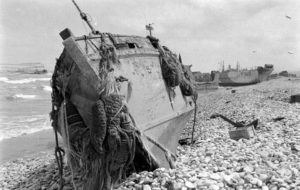
-
Omaha, après la tempête du 19 au 21 juin 1944, des épaves échouées sur les galets dont le MK4 britannique LCT-969
Voir le reportage sur les épaves à Omaha après la tempête:
https://www.flickr.com/search/?sort=date-taken-desc&safe_search=1&tags=epaveomaha&user_id=58897785%40N00&view_all=1
Pour aller plus loin:
http://omahabeach.vierville.free.fr/WebMulberry/85132-EpavesTempete.html
-
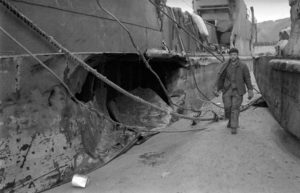
-
A Omaha, après la tempête du 19 au 21 juin 1944, un marin de l’US Navy marche entre des épaves échouées, à gauche un LCT (6)
le même marin et certainement le même LCT en LC001673 et LC001678:
https://www.flickr.com/photos/mlq/33492374435/in/photolist-T2Bb4D
Voir le reportage sur les épaves à Omaha après la tempête:
https://www.flickr.com/search/?sort=date-taken-desc&safe_search=1&tags=epaveomaha&user_id=58897785%40N00&view_all=1
Pour aller plus loin:
http://omahabeach.vierville.free.fr/WebMulberry/85132-EpavesTempete.html
-
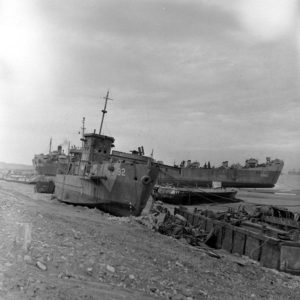
-
Vierville sur Mer, à la limite Dog White et Dog Red, sur un talus de galets, les épaves du LCI(L)-92 échoué depuis le 6 juin et celle du LST-543 échoué depuis la tempête du 19 au 21 juin.
LCI-92 pour aller plus loin:
http://omahabeach.vierville.free.fr/2622-LCI92.html
LST-543 pour aller plus loin:
reportage sur le LST-543 avant son échouage:
https://www.flickr.com/photos/mlq/8096446665/in/photostream
LST-543 échoué:
https://www.flickr.com/search/?sort=date-taken-desc&safe_search=1&tags=lst543&user_id=58897785%40N00&view_all=1
Voir le reportage sur les épaves à Omaha après la tempête:
https://www.flickr.com/search/?sort=date-taken-desc&safe_search=1&tags=epaveomaha&user_id=58897785%40N00&view_all=1
The importance of other ports.
Although troops and equipment will still be brought to Omaha in small quantities, it is the artificial ports installed on the other beaches of the Allied Landing will engulf this profusion of supplies. Thus, Mullberry ports such as Gold-Arromanches or Gooseberry of Utah-Sainte Marie du Mont, will play a key role in the supply of the front and the advance of the latter. For the example of Utah, it is not less than 836 000 men who will tread the sand of this small beach during the year 1944 because although the port of Cherbourg is released at the end of June, this one is unusable.
-
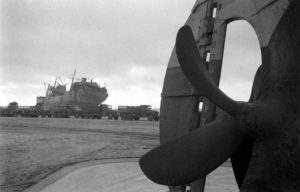
-
A Omaha, après la tempête du 19 au 21 juin 1944, un cargo échoué, en cours de déchargement à l’aide d’un convoi de GMC.
au premier plan l’hélice d’un second cargo également échoué
voir le reportage sur deux cargos échoués:
https://www.flickr.com/search/?sort=date-taken-desc&safe_search=1&tags=gmcomaha&user_id=58897785%40N00&view_all=1
Voir le reportage sur les épaves à Omaha après la tempête:
https://www.flickr.com/search/?sort=date-taken-desc&safe_search=1&tags=epaveomaha&user_id=58897785%40N00&view_all=1
Pour aller plus loin:
http://omahabeach.vierville.free.fr/WebMulberry/85132-EpavesTempete.html
-
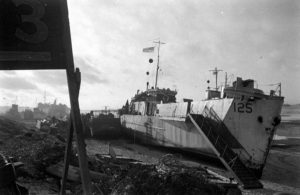
-
A Omaha, après la tempête du 19 au 21 juin 1944, plusieurs épaves dont le LCI(L)-125
http://www.navsource.org/archives/10/15/150125.htm
Voir le reportage sur les épaves à Omaha après la tempête:
https://www.flickr.com/search/?sort=date-taken-desc&safe_search=1&tags=epaveomaha&user_id=58897785%40N00&view_all=1
Pour aller plus loin:
http://omahabeach.vierville.free.fr/WebMulberry/85132-EpavesTempete.html
-
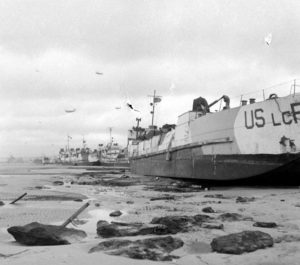
-
A Omaha, après la tempête du 19 au 21 juin 1944, plusieurs épaves échouées dont un Landing Craft (Flak) LCF échoué.
Voir le reportage sur les épaves à Omaha après la tempête:
https://www.flickr.com/search/?sort=date-taken-desc&safe_search=1&tags=epaveomaha&user_id=58897785%40N00&view_all=1
Pour aller plus loin:
http://omahabeach.vierville.free.fr/WebMulberry/85132-EpavesTempete.html
(Credits : NARA)
by Bertrand Froger | 2 Jul 2017 | Celebrations, Historical events, Places, WW2 News
A monument for Benjamin F. Kitchens and Bert Espy Jr
On June 24th, following the invitation of our friend Christian Levaufre, we gathered to inaugurate the memorial in memory of the two American airmen Benjamin F. Kitchens and Bert Espy Jr in Périers (50). Day after day 73 years, when the two pilots join their formation after firing German vehicles, Espy’s P-47 propeller will cut the back of the Kitchens aircraft. This terrible accident ended with the Thunderbolt crash and the death of the two USAAF officers. After a long research work carried out over decades by the Levaufre family and the association Normandy 44, Espy’s plane is found (that of Kitchens was thrown) and its engine cleaned. It is thus affixed at the top of this memorial unveiled this June 24th, 2017 in the presence of the French-American authorities but also of the pilot’s niece. A beautiful tribute, the loop is closed, because maintaining the flame of memory is 365 days a year.
All died for our Freedom
“Not all died as Heroes, but all died for our Freedom,” is the sentence quoted on the panel explaining the misadventure of these two airplanes. It is well to remember that no war is proper, and that no war is conducted without error. Among the millions of people who died in the Second World War, many of them were victims of fratricidal shooting because of problems of location, accidents at sea, in the air and on the land. Thus, although all these young men had sacrificed their lives for the liberation of our continent, many of them would surely have been able to return home if these errors had not occurred. We do not forget them either.
by Bertrand Froger | 10 May 2017 | Collections, Historical events, Life of soldiers
The M1 Garand: A gun that enters the Legend
The clips of 8 Cal.30 cartridges comes to supply the first semi-automatic rifle of the US army: the M1 Garand. The production of these clips was such that most of those produced during the Second World War were actually used by reconditioning with post-war ammunitions in the various American and other armed forces. However, reliable and robust, the M1 Garand will be used throughout the world thereafter, and for decades. Thus, many clips will be remanufactured. This alphabetical list will allow you to no longer have you. In Bold, you will find the apparent marking on the clip, followed by its origin. The words “WWII” will be entered if the clips are produced during this period, otherwise “Post WWII”. Failure to do so will help to maintain doubt and the list may evolve. The term “trade” indicates a commercial contract for distribution other than in the army.
List of Manufacturing of clips for M1 GARAND
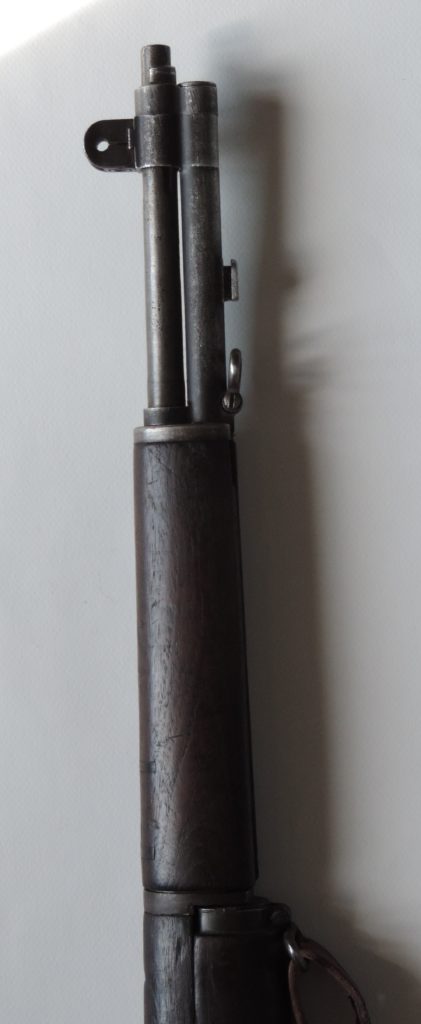
1 – Springfield Armory – Springfield, MA, USA (before WWII and WWII)
58 and 59 – Nationalist China (POST WWII)
ACE 2 – Aggressive Engineering Corp – Anaheim, CA, USA (Military Contract)
AEC 2 – Aggressive Engineering Corp – Anaheim, CA, USA (Trade)
AEC 3 – Aggressive Engineering Corp – Anaheim, CA, USA (Tradee)
AGE 1 – Aggressive Engineering Corp – Anaheim, CA, USA (Military Contract WWII)
AGE 2 – Aggressive Engineering Corp – Anaheim, CA, USA (Military Contract POST WWII)
AMP – All Metal Products – Wyandotte, MI,USA (WWII)
AMP 1 – All Metal Products – Wyandotte, MI,USA (WWII)
BLM – Barry L Miller Eng Inc. – Irvine, CA, USA (WWII)
BW – Borg Warner – Spring Division,Bellwood, IL, USA (WWII)
B-W 1 to B-W 10 – Borg Warner – Spring Division,Bellwood, IL, USA (WWII)
BR-W 1 to BR-W 8 – Borg Warner – Spring Division,Bellwood, IL, USA (POST WWII)
C – Springfield Armory – Springfield, MA, USA (before WWII and WWII)
C – Lerio Patent Cup Co. – Mobile, AL, USA (WWII)
C* – Lerio Patent Cup Co. – Mobile, AL, USA (WWII) CMP 3 – Aggressive Engineering Corp – Anaheim, CA, USA (Trade POST WWII)
Danly – Danly Machine Co – Chicago, Il, USA
DAQ – Dominion Arsenal Quebec – Quebec (POST WWII)
f – Fedder’s Manufacturing Co.- Buffalo, NY, USA (WWII)
fB – Fedder’s Manufacturing Co.- Buffalo, NY, USA (WWII)
fC – Fedder’s Manufacturing Co.- Buffalo, NY, USA (WWII)
fD – Fedder’s Manufacturing Co.- Buffalo, NY, USA (WWII)
fE – Fedder’s Manufacturing Co.- Buffalo, NY, USA (WWII)
fF – Fedder’s Manufacturing Co.- Buffalo, NY, USA (WWII)
HA – Haerens Ammunitions Arsenal – Copenhagen, Denmark (POST WWII)
IS – International Silver – Meriden, CT, USA (WWII)
IS1 to IS5 – International Silver – Meriden, CT, USA (POST WWII)
IMI – Israel Military Industries – Ramat Hasharon, Israël
JMO 68 – Julius Maurer – Oberstein, Allemagne (POST WWII)
JMO 69 – Julius Maurer – Oberstein, Allemagne (POST WWII)
JMO 70 – Julius Maurer – Oberstein, Allemagne (POST WWII)
JMO 71 – Julius Maurer – Oberstein, Allemagne (POST WWII)
JMO 72 – Julius Maurer – Oberstein, Allemagne (POST WWII)
JMO 74 – Julius Maurer – Oberstein, Allemagne (POST WWII)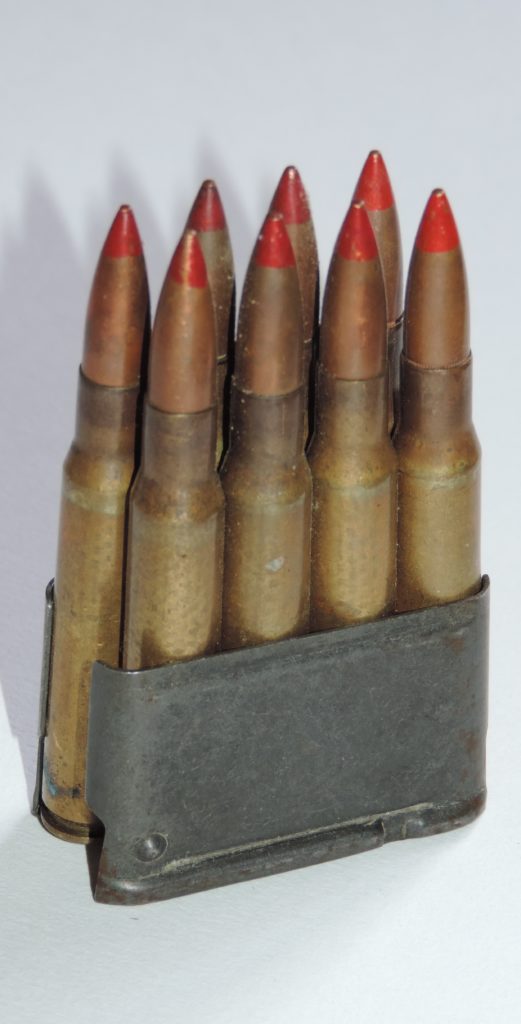
L&H 81 – Italy or Denmark (POST WWII)
LP 1955 – Italy (POST WWII)
LP 1956 – Italy (POST WWII)
LP 1961 – Italy (POST WWII)
MAS – Manufacture D’Armes de St Etienne – Saint Etienne, France (POST WWII)
MBZ – Murik & Ball Zeist – Pays-Bas (POST WWII)
MFT – Metaalwaren Fabrik Tiburg – Pays-Bas (POST WWII)
NW – Northwest Metal – Seattle, WA, USA (WWII)
O – Springfield Armory – Springfield, MA, USA (before WWII and WWII)
RW – R Wallace & Sons – Wallingford, CT, USA (WWII)
S – Stanley Works – New Britain, CT, USA (WWII)
S (in a circle) – ?
SA (Big) – Springfield Armory – Springfield, MA, USA (WWII)
SA (small) – Springfield Armory – Springfield, MA, USA (POST WWII)
SA (dash over) – Springfield Armory – Springfield, MA, USA (POST WWII)
SA (dash over and under) – Springfield Armory – Springfield, MA, USA (POST WWII)
S.F. – Serini France (POST WWII)
SW – Stanley Works – New Britain, CT, USA
TF&S – Thomas French & Co – Manchester, United Kingdom
5mm hole – Austria (POST WWII)
W1 to W6 – R Wallace & Sons – Wallingford, CT, USA (WWII)
WEP – Wade Electric Products – Sturgis, MI , USA
WEP1 à WEP5 – Wade Electric Products – Sturgis, MI , USA (WWII)
WRA – Winchester Repeating Arms – New Haven, CT, USA (WWII)
WRA Educational – Winchester Repeating Arms – New Haven, CT, USA (WWII)
by Bertrand Froger | 20 Apr 2017 | Anecdotes, Historical events, People
A cosmopolitan and multicultural family
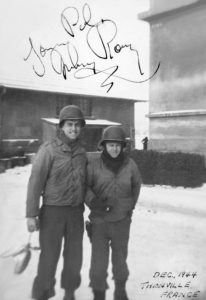 Albert Justin Ricciuti was born in 1923 on Lakewood Avenue in the east of Baltimore, Maryland. His father Raffaele, an Italian immigrant who had arrived in the United States at the beginning of the 20th century, had spent many years before understanding English. He had then joined the allied expeditionary forces and returned to Europe in 1917 to fight the German Empire. He had met Louise Pillier, a young French girl, who became his wife and joined him in his adopted country after the war. Following this international union, their son Albert grew up in Baltimore for years and then graduated from the Mont St. Joseph High School in Irvington in 1941. Thanks to his parents’ origins, the young man speaks several languages and it is his level of French which will interest the army during the Second World War.
Albert Justin Ricciuti was born in 1923 on Lakewood Avenue in the east of Baltimore, Maryland. His father Raffaele, an Italian immigrant who had arrived in the United States at the beginning of the 20th century, had spent many years before understanding English. He had then joined the allied expeditionary forces and returned to Europe in 1917 to fight the German Empire. He had met Louise Pillier, a young French girl, who became his wife and joined him in his adopted country after the war. Following this international union, their son Albert grew up in Baltimore for years and then graduated from the Mont St. Joseph High School in Irvington in 1941. Thanks to his parents’ origins, the young man speaks several languages and it is his level of French which will interest the army during the Second World War.
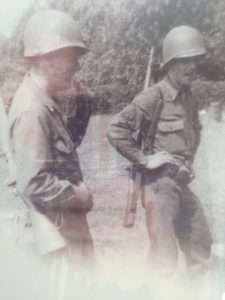
Albert also enlisted the army on January 22nd, 1943, and obtained the serial number 33552009. He then joined the 20th Corps of the 3rd Army of General Patton. Transferring quickly to Great Britain, he landed on Utah Beach on June 10th, 1944, 4 days after the start of operations in Normandy. Then its unit moved according to the progress of the operations, crossing the liberated regions of France one after the other, including Champagne. It was in Champagne that the young soldier, then twenty years old, met Paulette Révolte and his two sisters at Avenay-Val-d’Or. Through the practice of French, Albert and his comrades have more facility to communicate with French people. Beer lover, he discovers during his stay a new drink: Champagne, through good times spent with Paulette, who grew up in the vineyards. Then the front progressed and Albert finished the war and returned to the country while others did not have that chance. He then occupied a small barman job at Chiapparelli’s in Little Italy. However, once back, he has not forgotten the beautiful Paulette to whom he writes a greeting card every year during the Christmas period.
From trenches to vines
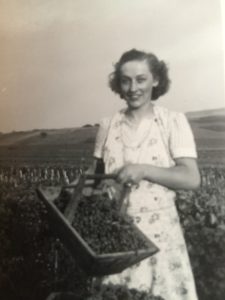 In 1962, Albert Ricciuti decided to return to Europe, 18 years after the end of the war to trace his course in the battle. This is the opportunity to visit his old friend Paulette and warn him that he will be visiting France and that he would like to see her again. The answer will not be delayed, Paulette will exclaim:
In 1962, Albert Ricciuti decided to return to Europe, 18 years after the end of the war to trace his course in the battle. This is the opportunity to visit his old friend Paulette and warn him that he will be visiting France and that he would like to see her again. The answer will not be delayed, Paulette will exclaim:
« I have so many new bottles of champagne to taste».
The lovers will marry a year later, eager to catch up all these years passed far from each other. Some formalities in the USA will be settled and Albert will move to France, in the village of Paulette. He was trained in wine and grape growing in the company of the Paulette family. In spite of himself, Albert Justin Ricciuti of Baltimore had just become the first American to produce Champagne. Wanting to learn constantly, Albert became a leader of the sector and the Ricciuti-Revolte Champagne was produced at no less than 50,000 bottles per year.
Multi-generational production
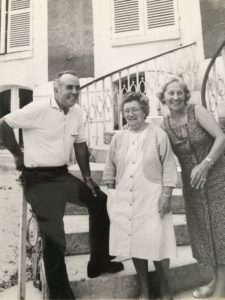
Albert Ricciuti, Hero of the Libertation of our country, passed away on June 17th, 2002 and Paulette unfortunately joined him on December 12nd, 2016. However, John Charles was born of this love in 1963, with an American father and a French mother. This son bears the names of two Franco-American symbols; John F. Kennedy, president with the tragic destiny, and Charles de Gaulle, leader of Free France during the war then president of France; and now thanks to his work the family business continues, the inheritance of a meeting and a unique know-how. Today he is proud to transmit his History and that of his name. It would appear that his son Ugo, who has just completed a BTS winegrower is already ready to take over and continue the tradition!
















